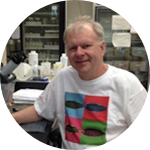About This Project
Refrigeration of vaccines accounts for 80% of the cost of sending vaccines to developing nations which amounts to approximately $200-300 million per year. We want to store the genes for viral antigens in yeast which can then be dried and shipped unrefrigerated to developing nations. The yeast can then be re-hydrated and made to produce the antigens which can then be filtered from the yeast and used as a vaccine. This would cut the entire cost associated with refrigeration.
Ask the Scientists
Join The DiscussionWhat is the context of this research?
Although we take it for granted that we live in a society in which most of us have received basic vaccinations and thus we aren't faced with the situation of losing our loved ones to a disease that could have easily been prevented, this is often the case in developing nations. The correct utilization of our resources can result in the lives of many being saved through them receiving proper vaccinations. Most of the cost of sending vaccines to developing nations is due to refrigeration and thus our team plans to cut the entire cost of refrigerating vaccines by 'storing the vaccines' in dried yeast which do not need to be refrigerated.
What is the significance of this project?
The significance of this project is that we are going to demonstrate that vaccines can be stored via dried out yeast which introduces a radically different way of attaining vaccine stabilization.
What are the goals of the project?
The goals of our project is to:
1) Transform the genes for the Hepatitis B surface antigen into yeast (currently an antigen used to make vaccines).
2) Dry out the yeast, re-hydrate them, and then demonstrate that they can produce the antigen after the drying and re-hydrating process.
Budget
We plan on synthesizing via IDTDNA the Hepatitis B Surface antigen (HBsAg) which is the antigen we'll be using to show that a vaccine can be stored via yeast. After the gene for HBsAg arrives, we'll transform that into E. Coli ( the DH5 alpha ultra competent cells) which then need to be selected from the ones that didn't transform using white-blue screening (which requires the X-Gal media). We then will purified the HBsAg gene from the E. Coli which will then be transformed into yeast. The yeast needs to first be grown up in regular yeast media (consisting of Extract, Peptone, Agar) and then switched to yeast dropout media in order to select for the yeast that contains the HBsAg gene. The yeast will then be secreting the antigen ( we attached a secretion tag to the HBsAG gene) into the media which can then be detected (Using ELISA HBsAG Kit).
Of course there are other items involved (and other steps), but those we possess already.
Endorsed by
Meet the Team
Team Bio
Jonathan Krog - Biomedical Engineering Major
Noah Michelson - Biomedical Engineering Major
Omar Zainul - Pharmacology Major
Jonathan Kelly - Biology major
Brian Yang - Biology and Economics Double Major
Sunil Deochand
I'm currently a senior undergraduate researcher conducting research in a yeast lab in which I analyze the genomes of various strains of yeast.
Lab Notes
Nothing posted yet.
Project Backers
- 3Backers
- 9%Funded
- $78Total Donations
- $26.00Average Donation

